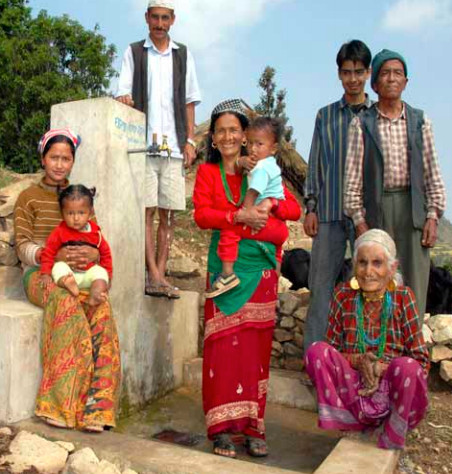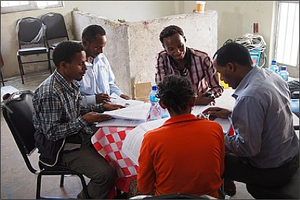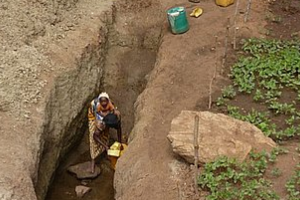Difference between revisions of "वाटर पोर्टल / वर्षाजल सचंयन / तीन आर (रिचार्ज, रिटेंशन और रियूज)"
| Line 16: | Line 16: | ||
वाश कार्यक्रम का फोकस घरेलू जल आपूर्ति और स्वच्छता पर केंद्रित होता है, जो मुख्यतः घरेलू और सामुदायिक स्तर पर ही होता है, यह समेकित जल संसाधन प्रबंधन कार्यक्रमों की तरह खेतों के लिए नहीं होता है. हालांकि वाश कार्यक्रम और भोजन और ऊर्जा से संबंधित दूसरे क्षेत्रों के बीच अधिक संपर्क बढ़ाने की कोशिशें की जा रही हैं. इसने वाश कार्यक्रम को फिर से सोचने के लिए प्रेरित किया है और जलग्रहण के लिए सामुदायिक नजरिये को विकसित करने की दिशा में यह बढ़ रहा है. | वाश कार्यक्रम का फोकस घरेलू जल आपूर्ति और स्वच्छता पर केंद्रित होता है, जो मुख्यतः घरेलू और सामुदायिक स्तर पर ही होता है, यह समेकित जल संसाधन प्रबंधन कार्यक्रमों की तरह खेतों के लिए नहीं होता है. हालांकि वाश कार्यक्रम और भोजन और ऊर्जा से संबंधित दूसरे क्षेत्रों के बीच अधिक संपर्क बढ़ाने की कोशिशें की जा रही हैं. इसने वाश कार्यक्रम को फिर से सोचने के लिए प्रेरित किया है और जलग्रहण के लिए सामुदायिक नजरिये को विकसित करने की दिशा में यह बढ़ रहा है. | ||
| − | + | पानी की मांग के बढ़ने और इसके पर्यावरण पर नकारात्मक प्रभाव पड़ने की वजह से जलग्रहण क्षेत्र में प्रभावी तरीके से जल संग्रह करना बहुत आवश्यक हो गया है. [http://www.bebuffered.com तीन आर (रिचार्ज, रिटेंशन और रि-यूज) का नजरिया] न सिर्फ जल और खाद्य सुरक्षा से संबंधित जलग्रहण क्षेत्र में अधिक जल के प्रबंधन को बढ़ावा देता है, बल्कि साथ ही साथ जलग्रहण क्षेत्र में जल संकट झेल रहे समुदायों की भी मदद करता है. हालांकि स्थानीय योजना और इसे लागू करने के मामले में तीन आर नजरिया अभी तक चुनौतीपूर्ण है. | |
'''Requirements & limitations'''<br> | '''Requirements & limitations'''<br> | ||
Revision as of 15:29, 22 November 2015
| |
|
|
|
|
|
|
|
|

तीन आर के समर्थन में ये तीन महत्वपर्णू तर्क हैं:
1. पर्यावरण परिवर्तन के साथ तालमेल
बारिश के पैटर्न में बदलाव की वजह से लोगों की आजीविका और उनकी माली हालत पर असर पड़ता है. ऐसी परिस्थिति में जल संग्रह पर्यावरण परिवर्तन के साथ तालमेल बिठाने में एक महत्वपूर्ण कारक साबित होता है. यह पानी की उपलब्धता और उसकी मांग के बीच समय की खाई को भी पाटता है. भूमिगत जल, सतही जल और संग्रहण तंत्र में जल के अधिक होने पर इसका इस्तेमाल करने के कई लाभ हैं. इस तंत्रों के जरिये लोगों को पेयजल, पशुओं के पीने के लिए पानी, सिंचाई के लिए और दूसरे मकसद के लिए पानी उपलब्ध कराया जा सकता है. पानी तक पहुंच भी पर्यावरण और वृहत पारिस्थितिकी तंत्र को लाभ पहुंचाती है. पानी का संग्रह करते हुए हम जरूरत के वक्त में इसका इस्तेमाल कर सकते हैं.
2. जल चक्र में पुनर्नवीकरण
जल प्रबंधन को अक्सर जल संसाधन के आवंटन, उपलब्धता और क्षमता वृद्धि तक ही सीमित कर दिया जाता है. ऐसे में अक्सर अधिक जल के उपयोग, जल नवीकरण और अधिक जल का दुबारा उपयोग जैसे उपाय पीछे रह जाते हैं. तीन आर जल संसाधनों की मात्रा और गुणवत्ता में स्थायी तौर पर वृद्धि मुमकिन है. जरूरत से अधिक उपलब्ध जल के इस्तेमाल और दुबारा इस्तेमाल से जल की क्षमता में वृद्धि होती है, क्योंकि यह इस्तेमाल और दुबारा इस्तेमाल के जरिये जल से संबंधित विवादों का समाधान भी कर देता है.
3. हरित जल प्रबंधन
भूमिगत स्रोतों में जल की अधिक मात्रा से मिट्टी की नमी बरकरार रहती है और भूमिगत स्रोतों में जल की उपलब्धता तो बढ़ती ही है. इस तरह यह हरित जल प्रबंधन की दिशा में महत्वपूर्ण योगदान होता है. हरित जल प्रबंधन एक ऐसा प्रबंधन है जो संवर्धित जुताई, गुड़ाई, भौतिक-रासायनिक और जैविक प्रक्रियाओं पर आधारित है. मिट्टी में जल की उपलब्धता बढ़ाते हुए, तीन आर हरित जल प्रबंधन में इस तरह योगदान देता है कि इससे पारिस्थितिकी तंत्र और कृषि उत्पादन दोनों में सकारात्मक बदलाव आये.
Contents
तीन आर योजना उपकरण
वाश कार्यक्रम का फोकस घरेलू जल आपूर्ति और स्वच्छता पर केंद्रित होता है, जो मुख्यतः घरेलू और सामुदायिक स्तर पर ही होता है, यह समेकित जल संसाधन प्रबंधन कार्यक्रमों की तरह खेतों के लिए नहीं होता है. हालांकि वाश कार्यक्रम और भोजन और ऊर्जा से संबंधित दूसरे क्षेत्रों के बीच अधिक संपर्क बढ़ाने की कोशिशें की जा रही हैं. इसने वाश कार्यक्रम को फिर से सोचने के लिए प्रेरित किया है और जलग्रहण के लिए सामुदायिक नजरिये को विकसित करने की दिशा में यह बढ़ रहा है.
पानी की मांग के बढ़ने और इसके पर्यावरण पर नकारात्मक प्रभाव पड़ने की वजह से जलग्रहण क्षेत्र में प्रभावी तरीके से जल संग्रह करना बहुत आवश्यक हो गया है. तीन आर (रिचार्ज, रिटेंशन और रि-यूज) का नजरिया न सिर्फ जल और खाद्य सुरक्षा से संबंधित जलग्रहण क्षेत्र में अधिक जल के प्रबंधन को बढ़ावा देता है, बल्कि साथ ही साथ जलग्रहण क्षेत्र में जल संकट झेल रहे समुदायों की भी मदद करता है. हालांकि स्थानीय योजना और इसे लागू करने के मामले में तीन आर नजरिया अभी तक चुनौतीपूर्ण है.
Requirements & limitations
This planning tool focuses on projects carried out by the 3R consortium in Ethiopia and Nepal. Although the aim is to develop a planning tool, which can be applied in different contexts, it will not be possible to simply apply the tool for Ethiopia and Nepal to any other country without some adaptations. The planning tool will be mainly developed for non-governmental and governmental actors working in the field of water management and spatial planning.
Description & results
In Nepal of 2012, RAIN and Acacia Water started to develop the 3R methodology, which supports implementing organisations to integrate the 3R approach into their project planning. This method enables opportunities and challenges within an area to be included by looking at both the physical and social environment. MetaMeta and RAIN worked in 2012 on building capacity of local governments on 3R as part of the existing natural resource management framework in Ethiopia. Both projects showed that there is a strong need for 3R as a planning tool in water management projects. But knowledge, capacity and commitment are needed to actually change current planning processes of non-governmental and governmental organisations.
To respond to this need, RAIN and its partners within the 3R consortium will develop a 3R planning tool and practical training modules:
- In Nepal, RAIN is working together with Helvetas Swiss Int. Nepal to develop a similar 3R module for their WUMP planning tool,
- In Ethiopia, RAIN and MetaMeta are developing training modules for 3R planning and implementation.
Catchment Assessment Tool
RAIN, together with Practica Foundation and Wetlands International, will develop a catchment assessment tool that will support WASH projects to work with an area-driven (instead of a technology-driven) approach. Many catchment assessment tools exist, but these are often too complex for small-scale planning of RWH projects. The catchment assessment tool is based on RAINs RWH decision support tool (under development) and other existing catchment assessment tools.
Requirements & limitations
The tool can be used for small-scale catchment planning purposes focusing mainly on water scarce or water stressed areas. The tool will be mainly developed for implementers and decision makers in WASH programmes in developing countries.
Description & results
The catchment assessment tool supports planning of WASH interventions at the earliest stages and takes into account opportunities and risks of the project area or catchment. It will focus on environmentally sustainable approaches and will support informed decision-making in WASH programmes.
RWH Decision Support Tool
In 2010, RAIN developed an online RWH decision support tool in a Wiki environment. The goal of this project was to develop a planning and decision tool to guide implementation, upscaling and integration of RWH into water management programmes. It consists of 14 steps, which will guide the user through the different aspects concerning water harvesting.
The tool links to a library containing additional information about specific aspects of water harvesting, such as water quality issues, but also provides information on good practices in water harvesting. More information can be found in the final report.
Description & results
The tool has not been published online mainly due to the fact that it was seen as too complex (14 steps) and therefore not user-friendly. RAIN now aims to repackage the current tool into a more user-friendly tool. This tool is coming soon.
3R field experiences
The following projects utilize 3R using recharge, retention and reuse.
 Introducing 3R in impact area of DWA |
 Scale up of Sustainable Water Access |
 Introducing 3R in impact areas of DWA |
Documents, videos and links
- 3R Smart Solutions
- PDF: WATER USE MASTER PLAN (WUMP): A concept to equitably share water resources within and amongst rural communities. HELVETAS PROJECT EXPERIENCE.
- Be Buffered: This Area is Prepared for Floods and Droughts, is Yours? 3R Water Secretariat.
- ARTICLE: Managing the Water Buffer: For Climate Change Adaptation and Food Security. By Ethiopian Institute of Water Research, Federal Institute for Geosciences and Natural Resources and MetaMeta.
- Lots of articles about reusing water for agriculture: Agropedia.
